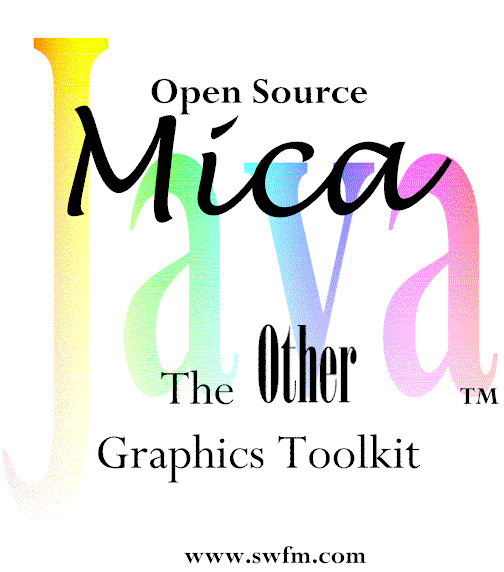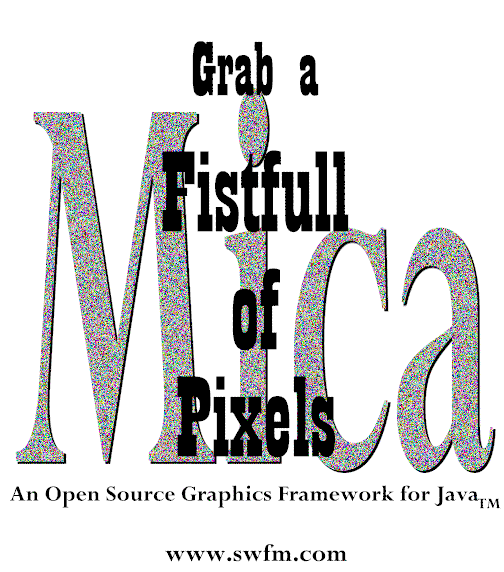| |
|
| |

--------Mark 2--------- |
December 22,
2005 |
|
Continuing to document Mica
classes. There are over 800 classes, but optimistically
about half has been unofficially documented over the years
- so we are not looking eternity in the face here.
Mica is still JDK 1.4
compatible, though it is also being used to good effect
with the JDK 1.5-based Obsidian Framework.
Some classes have been moved
around with the idea that the parts, view,
model and controller (and potentially even
the widgets) packages can be left out of some types
of Mica applications with the idea of making Mica lighter
and even better for online graphics applications. Mica.jar
is 2MB now and it would be great to get it down to 1MB or
so. |
December 9,
2005 |
|
| |
Mica
javadocs are now online. Mica classic has been divided up
into packages and some classes moved around some.
Still lots of documentation to add...as always. |
| |
. |
| |
November 11,
2005 |
| |
Mica still has the same
features as Mica Classic except for the following general
changes:
- The general utility
classes have been moved out of Mica into a separate package
- The single package
approach of Mica Classic has been changed to a more standard
package-per-subdirectory approach - to make navigating
javadocs easier if for no other reason.
- Much of the higher
level MVC classes (mostly found in the /model directory)
will be removed
- Many of the higher
level custom widgets in the /parts directory will be moved
and replaced, functionally, by the XML-driven Obsidian
Framework widget-generation capabilities.
Mica has complete support for
advanced features such as infinite undo/redo, zoom and pan, network graph
layouts and interactive graph templates, connections and connection
points, annotations and annotation points, event handling and action
percolation, layers and layer tabs, arrows, shadows, cut/copy/paste
to/from clipboard, multiple printable pages, postscript, jpeg, and pdf
output, rulers, toolhints, status bars, tool bars, complete working network and diagramming
editors, graphics editor toolkit, and more... |
| |
|
| |
Mica is evolving and becoming a part of the
Obsidian framework |
| |
Mica classic will
still be around, but Mica 2.0 will be stripped down,
partitioned into separate libraries, and with the MiModel
front end replaced with the binders and generic data
structures of the Obsidian Framework - and all in declarative XML. |
| |
|
| |
 |
| |
|
| |

 |
| |
|
| |
|
|
|
|
 |
|
|
Screenshots
| |
| |

Everything, from the menubar and scrollbars
to the grid in the editor is 100% Mica in this window. |
Downloads |
|
|
|
See
Mica Classic |
|
|
|
|
|
|
|
|
|
|
|
|
|
 |
|
|
Documentation
|
|
See Mica
Classic |
| |
| |
|
A Java
Object-Oriented 2D Vector Graphics and User Interface Framework.
Includes diagramming and network graphics editors. Free with source
code. |
| |
| |
| Mica is a 2D,
high-level, full-featured, object-oriented, hierarchical,
structured, resolution-independent, mixed graphics and user
interface widget library with multiple levels of drawing
abstraction written completely in Java.
2D
The system provides extensive
support for rendering and manipulation of vector and raster
graphics in two dimensions
High-level
A highly-customizable 'Graphics
Window Object' is provided that supplies much of the
functionality associated with 2D drawing programs.
Full-featured
Many graphics shapes, user
interface widgets, interactors, and demo applications are
included.
Object-oriented
All graphics shapes, user
interface widgets, interactors, layouts, connections, etc. are
objects and sub-classable by the programmer.
Hierarchical
Graphics shapes and user
interface widgets can be arbitrarily arranged in
container-part and reference-part directed acyclic graphs.
Structured
Graphics shapes and user
interface widgets can be connected together with first-class
connection objects into any number of directed or undirected
(network) graphs.
Resolution-independent
The sizes and locations of
graphics shapes and user interface independent widgets are
specified in device-resolution-independent floating point
coordinates and so have the same appearance and relative size
regardless of the size or dots-per-inch of the particular
screen or printer used for display.
Mixed graphics
Graphics shapes and user
interface widgets share the same coordinate space, the same
API and are of the same basic type.
Multiple levels
A variety of
functionality/performance trade-off options are available from
heavy-weight, full-featured graphics shapes to
very-light-weight simple graphics shapes to an immediate
rendering mode (in resolution-independent coordinates).
Written in Java
The robustness, ease-of-use,
portability and the other buzzwords of Java are inherited by
this software.
|
|
|
|